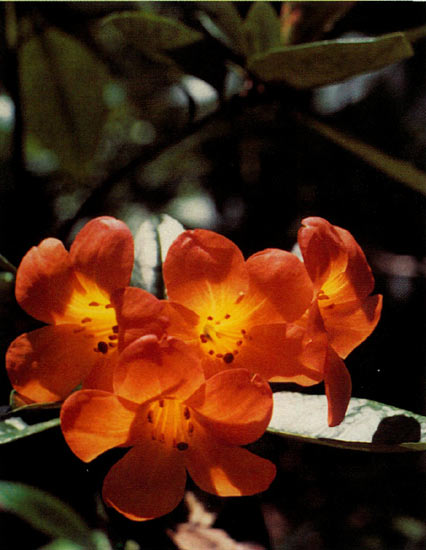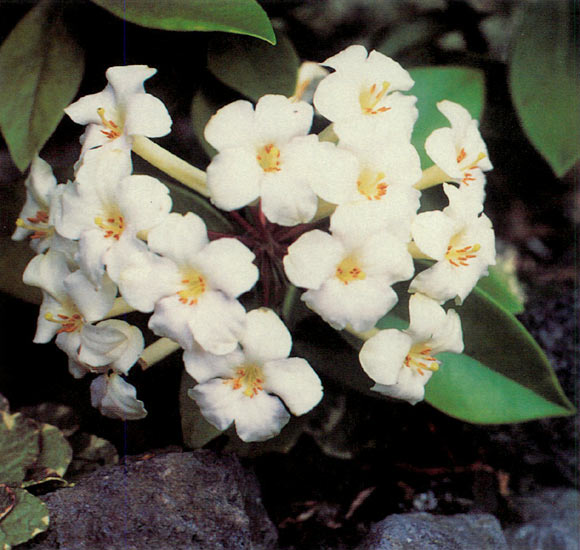Vireyas in Hawaii
R.A. "Mitch" Mitchell
Volcano, Hawaii
What did you call me - a vireyaholic? When I first heard this word I had no idea what it meant, but now I do. What better way to explain my choice to go to the 1996 ARS convention in Oban, Scotland, from Volcano, Hawaii, via Sabah, Malaysia, to look for vireya species on Mt. Kinabalu. And, as if that doesn't sound weird enough, how about flying 14 hours from Singapore to meet two other vireyaholics, Dick Chaikin and White Smith, to visit gardens between London and Oban.
We were joined by our English connection, John Bodenham, who had fine tuned the itinerary developed by Dick, and began garden hopping on April 13. At the beginning John's lovely wife, Margaret, joined us for some of the visits, and later we three Americans started off on our own in a rental car. By the time we arrived in Oban on May 5 we had visited nearly 60 of Britain's greatest gardens. And more were added during the Oban convention and afterwards bringing the total to 68.
An account of that fabulous experience will have to wait, because for now I've been asked to write about growing vireyas in Hawaii. My story begins in 1982 when my wife, Sandy, and I retired, and we took two major steps. We moved to Volcano on the Big Island (called Hawaii) and bought a narrowboat in England where we spent three summers cruising about 2,000 miles of canals and rivers. And it was then that we fell in love with rhododendrons.
Neither of us, however, had any background in botany or horticulture. Sandy had spent many years as a donor recruiter for the Blood Bank of Hawaii, and I retired as president of a large printing company in Honolulu. This background hardly prepared us for growing rhododendrons so we began asking lots of questions.
When I told our British friends about our growing conditions in Volcano they said, "Oh, you won't have any problem growing rhododendrons." You see, I had told them that we have an acid soil with a pH of about 5 and we have no trouble growing azaleas, hydrangeas, camellias and others that like acid soil conditions. Altitude is 4,000 feet where the temperatures go to the mid 30s Fahrenheit in the winter and the nights are usually cool the year around.
Under 3 to 4 feet of humusy soil is lava that originally erupted from the volcano above us. Of course this is very porous and gives our plants perfect drainage conditions. This is essential because living in a rain forest where the rainfall is between 175 to 240 inches that amount of water must disappear fast or we would have an interesting problem to cope with. To give you an idea of what I mean, the lowest point in our garden will collect nearly 3 feet of water during the heaviest part of a rainstorm, but as soon as it lets up that lake disappears like a toilet that has just been flushed.
Perhaps you too would say that we have ideal growing conditions for rhododendrons, but we later found that one vital element was missing. Have you guessed what it is?
During our canal cruising in 1984 we heard much about the coming International Rhododendron Symposium scheduled to be held in Federal Way, Washington, in 1985. The timing was just right for us to register on our way back to our boat in England. At the symposium we had a wonderful time meeting knowledgeable rhodo enthusiasts from many parts of the world. One of these was E. White Smith, who had recently started editing a newsletter called the
Vireya Vine
. When I told him that our English experience had motivated me to buy a number of rhododendron plants from several nurseries in the Northwest but that they weren't doing too well he quickly said that I should try vireyas.

|
|
Mitch Mitchell in his garden
at Volcano, Hawaii. Photo by Clarice Clark |
My inquiries as to nursery sources where I could buy vireyas led me to Bill and Bette Moynier's Vireya Specialty Nursery in Los Angeles (it is closed now). Within a short time I was being thrilled by the vibrant colors of vireyas, and I began to understand what a vireyaholic is. Since those early days I've added a number of vireyas from several other nurseries including the Rhododendron Species Foundation, from cuttings given to me by friends and from seeds received from Bill Moyles at the ARS Seed Exchange.
Yes, I still have many of the "hardies" bought at the beginning, but they still languish.
Rhododendron
'Vulcan' put on a fair show last year but nothing like I've seen in other gardens. The others struggle to put out a truss or two, but for the time being I am keeping them all because I can't stand to discard growing plant material, and we enjoy the foliage.
Have you guessed the missing element that we don't have which hardy rhododendrons require for blooming? Sure, our temperatures go low enough to produce the dormancy needed - but just at night. In the afternoons the thermometer will show 70s and 80s Fahrenheit. No one mentioned until sometime later that temperatures must stay in the 30 to 40 degrees Fahrenheit range night and day for three to four weeks to provide the dormancy required.
We are amused by some of our early experiences and compare them with what we are doing now. We began by being very timid. All the literature and nursery instructions stress how careful one should be in selecting just the right medium and using carefully selected containers. The size of the pots was important, and one even said the color should be white. I carefully followed all of these guidelines until by accident I discovered that those writers were talking about raising vireyas as indoor plants, and from that point of view their words of caution were very sound.
But after much trial and error I discovered I could overlook many of their words of caution, although some must not be ignored. For example, the drainage must be perfect, and this is most important because they are very susceptible to root rot. A fungicide like Subdue and Aliette must be used too. One expert even says that Subdue must be used around the roots in the spring and Aliette on the foliage in the fall.
As for medium, I use a mulch made from putting dead tree fern fronds in a shredder and mixing it with some peat and screened lava cinders. I also add some pumice which I find just above the lava level when digging holes. When planting I dig to the lava level and fill about half of the hole with lava cinder and put the medium on top of that.

|
|
Vireya 'Red Prince' grows in shade of
tree ferns in the Mitchell garden. Photo by Mitch Mitchell |
A word about location. I began by giving them too much shade because some of my reading said they get sunburn quite easily. However, a friend who lives near sea level and gets many blooms suggested I put them in direct sunlight. This does produce many more flowers, and I've seen little sunburn on most plants. However, there are some, mostly species, that prefer semi-shade, so it's a matter of trying different locations until just the right spot is found. Remember, we do live in a forest and finding sunny spots is not easy.
My initial instructional materials stressed that little fertilizing was required. It took a while for this non-horticulturist to realize that so much rain does leech away many nutrients, so on the advice of a local friend who has a long background in gardening I began fertilizing three or four times a year with a moisture release preparation called "Blue Chip" that comes from Oregon.
I mentioned earlier that I hate to throw away live plant material so you won't be surprised that when I prune these fast growing plants I use the cuttings as ground cover and just stick them in the ground with no rooting hormone. Many of them root, and I realize that someday someone will have a problem with so many plants. I won't be here when that day comes so I can be amused thinking about what someone will have to do with them.
![['Dr. Hermann Sleumer' x
(R. macgregoriae x R. aurigeranum)]](Fig40.jpg)
|
|
['Dr. Hermann Sleumer' x (
R. macgregoriae
x
R. aurigeranum
)].
Photo by Clarice Clark |
This reminds me that at an ARS member's home I remarked that I thought I was too old to think of hybridizing. He told me that he had been diagnosed with cancer 20 years earlier and he was convinced that it was his curiosity to see his crosses in bloom that kept him alive. So I began to make crosses and the other day potted my fifteenth attempt. True to form, when I get to about a dozen pots I stick the remaining seedlings in crevices on the sides of tree ferns which, by the way, can have trunks 12 to 14 feet high with fronds going up another 10 feet. And sometimes I stick them in clumps of moss, which was motivated by my visit to Sabah where I saw this happening in the wild.
Lest you have come to the conclusion that we don't have any problems, let me tell you about an unusual one. It's called "vog" and is created by Kilauea volcano which has been erupting almost constantly since 1984. Its lava doesn't create a hazard to us because the eruption site is far enough away. However, it emits various gases into the atmosphere which creates the vog, and when followed by rain of course the result is acid rain. When this falls on plants the result is "vog damage, a phrase heard frequently around here.

|

|
|
|
'Vladamir Bukowsky'
Photo by Mitch Mitchell |
R. jasminiflorum
Photo by Mitch Mitchell |
On vireyas the damage doesn't look like that on other plants, and it had me stumped for some time. Furthermore, it doesn't affect all vireyas. In fact, one right next to a group of other vireyas will get it while the others won't. Finally I took some of the affected leaves to the plant pathologist at the University of Hawaii-Hilo, and after a look through his microscope he said that it was unquestionably pestolotia.* He added that it was a secondary infection and that he couldn't tell what caused it. I told him that my theory was that vog damage weakened the leaf and made it susceptible to pestolotia. He said only that this might be possible. Again some trial and error seems to have produced good results. I remove the damaged leaves and destroy them. Then I spray the entire plant with liquid Sevin. The new growth looks great, and so far I haven't seen pestolotia on plants treated in this way.
Growing vireyas has turned out to be one of the more fascinating discoveries I've made in my 79 years, and I'm looking forward to sharing photos of some of my crosses.
* Pestolotia rhododendri . Pestolotia ssp. are often referred to as weak parasites or saprophytes on rhododendron foliage. They often invade these plants after winter damage, sunscald, or other injury and cause damage beyond that which could rightly be attributed to the various stress factors alone. "Compendium of Rhododendron and Azalea Disease" edited by Duane L Loyier and Martha K. Roane and published by The American Phytopathological Society in 1986.
Mitch Mitchell is a member of the Southern California Chapter and was one of the hosts of the vireya meeting in Hawaii in February that a number of ARS members attended.